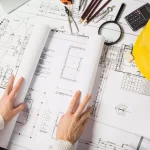The following is a brief introduction to the topic:
Cities are the heartbeat of modern life. They house over half of the world’s people and serve as engines for innovation, culture, and commerce. Rapid urbanisation comes with immense challenges, including climate change, housing shortages, and traffic congestion.
By 2025, architects, urban planners, and designers will pioneer the creation of inclusive, resilient, and tech-savvy cities. This will ensure that urban life is not only sustainable but also thriving for future generations.
1. Green Infrastructure Becomes Commonplace
The urban environment is integrating technology and nature in a way that has never been seen before.
- Rooftop gardens and green corridors reduce heat islands and absorb carbon
- Permeable pavements and urban wetlands manage stormwater and prevent floods
- Urban Forests Improve air quality and provide recreational opportunities
Vancouver and Copenhagen are leading the way with “nature-based” solutions that turn concrete jungles into green oases.
2. The Rise of Walkable, Bikeable Cities
In 2025, cities will prioritise people over automobiles.
- Wider sidewalks with protected bike lanes
- Zones are pedestrian-only and car-free
- Micro-mobility such as e-scooters, bike-sharing and scooters
- Integrating public transit hubs and walkable neighbourhoods
This trend is good for health, reduces emissions and helps local businesses.
3. Affordable & Modular Housing Innovations
Smart, scalable solutions are needed to address the housing shortage.
- Prefabricated modular homes reduce costs and construction times
- Reuse of old warehouses, factories and other buildings to create affordable housing
- Mixed-income housing that promotes social diversity
- Vertical villages with homes, shops and green space in one building
Tokyo and Barcelona will be pioneering innovative housing in 2025 that is both humane and inclusive.
4. Smart Cities Powered by Data & AI
Data is shaping the efficiency of cities, from traffic flow to energy consumption.
- AI-powered traffic management reduces congestion
- Smart grids are designed to optimise water, electricity and waste management
- Sensors measure pollution, noise and public safety
- Apps provide citizens with city planning and services.
These technologies help cities become more transparent, responsive and user-friendly.
5. Preservation Meets Progress: Heritage in Modern Urbanism
In 2025, urban design will combine historic preservation and innovation.
- Restoring landmarks using sustainable materials
- Cultural hubs and community centres can be created through adaptive reuse
- Integrating traditional street patterns and new transit systems
- New architecture celebrates local identity
It creates cities which respect their history while embracing the present.
6. Transit-Oriented Development (TOD)
Designing neighbourhoods around public transportation can reduce the reliance on personal vehicles.
- Mixed-use development near rail, bus and metro stations
- Connecting transit hubs with walkable streets and bikeways
- Affordable housing near job centres
TOD improves the quality of life and reduces carbon footprints.
7. Vertical Urbanism: The Future of Density
Cities are growing upward and inward as space shrinks.
- Skyscrapers that have mixed-use: offices, residential, retail and public parks
- Vertical farming for local food production is integrated into buildings
- Sky bridges, communal terraces and connecting buildings
- Towers that combine solar panels with wind turbines and energy-efficient technology
Vertical living is a great way to maximise space and foster community.
Conclusion: Building Resilient Cities for People & Planet
Urban innovation in 2025 shows that smart designs, sustainability, and inclusivity are key to creating cities that are not just places to live but places that thrive.
The future city will be:
- Green and Breathable
- Walkable and connected
- Affordable and Diverse
- Smart and adaptive
The blueprints of the future are architecture and urban planning. 2025 will be the year that we begin to build it better.





